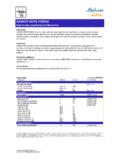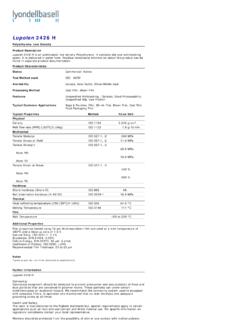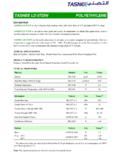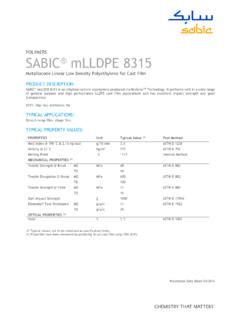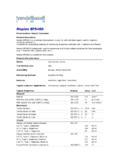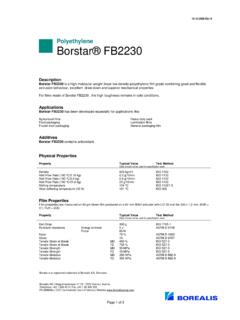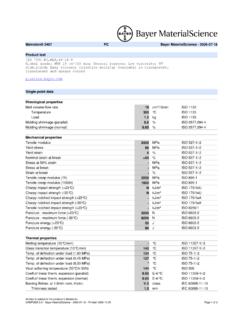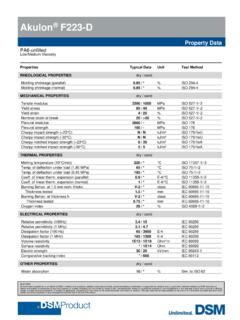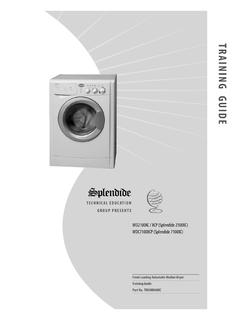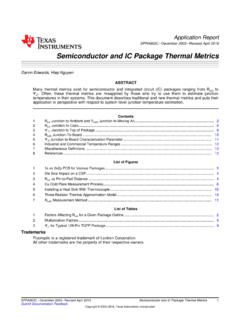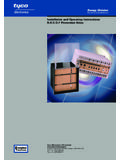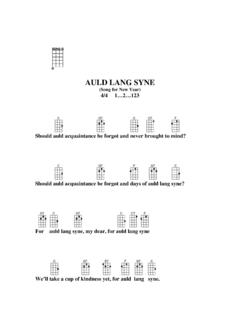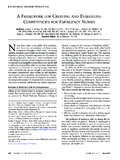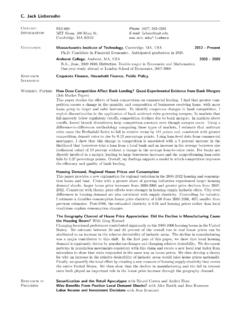Transcription of HOSTAFORM® C 9021 | POM | Unfilled
1 HOSTAFORM C 9021 | POM | Unfilled Description Chemical abbreviation according to ISO 1043-1: POM. Molding compound ISO 9988- POM-K, M-GNR, 03-002. POM copolymer Standard-Injection molding type with high rigidity, hardness and toughness; good chemical resistance to solvents, fuel and strong alkalis as well as good hydrolysis resistance; high resistance to thermal and oxidative degradation. Fulfils EG-directive 2002/72/EU as well as the recommendation XXXIII for consumer goods of the BgVV, corresponding to FDA-regulation for food contact. UL-registration for all colours and a thickness more than mm as UL 94 HB, temperature index UL 746 B electrical 110 C, mechanical 90 C. Burning rate ISO 3795 and FMVSS 302 < 75 mm/min for a thickness more than 1 mm. Ranges of applications: automotive engineering, precision engineering, electric and electronical industry, domestic appliances.
2 FDA = Food and Drug Administration (USA). BgVV = Bundesinstitut f r gesundheitlichen Verbraucherschutz und Veterin rmedizin FMVSS = Federal Motor Vehicle Safety Standard (USA). UL = Underwriters Laboratories (USA). Physical properties Value Unit Test Standard Density 1410 kg/m ISO 1183. Melt volume rate (MVR) 8 cm /10min ISO 1133. MVR test temperature 190 C ISO 1133. MVR test load kg ISO 1133. Mold shrinkage - parallel 2 % ISO 294-4. Mold shrinkage - normal % ISO 294-4. Water absorption (23 C-sat) % ISO 62. Humidity absorption (23 C/50%RH) % ISO 62. Mechanical properties Value Unit Test Standard Tensile modulus (1mm/min) 2850 MPa ISO 527-2/1A. Tensile stress at yield (50mm/min) 64 MPa ISO 527-2/1A. Tensile strain at yield (50mm/min) 9 % ISO 527-2/1A. Nominal strain at break (50mm/min) 30 % ISO 527-2/1A.
3 Tensile creep modulus (1h) 2500 MPa ISO 899-1. Tensile creep modulus (1000h) 1300 MPa ISO 899-1. Charpy impact strength @ 23 C 180P kJ/m ISO 179/1eU. Charpy impact strength @ -30 C 160 kJ/m ISO 179/1eU. Charpy notched impact strength @ 23 C kJ/m ISO 179/1eA. Printed: 06. March 2007 Page: 1. Ticona - A business of Celanese HOSTAFORM C 9021 | POM | Unfilled Mechanical properties Value Unit Test Standard Charpy notched impact strength @ -30 C 6 kJ/m ISO 179/1eA. Thermal properties Value Unit Test Standard Melting temperature (10 C/min) 166 C ISO 11357-1,-2,-3. DTUL @ MPa 104 C ISO 75-1/-2. Vicat softening temperature B50 (50 C/h 50N) 150 C ISO 306. linear therm. expansion (parallel) E-4/ C ISO 11359-2. linear therm. expansion (normal) E-4/ C ISO 11359-2. Flammability nom.
4 Thickn. HB class UL94. thickness tested ( ) mm UL94. UL recognition ( ) UL - UL94. Flammability at thickness h HB class UL94. thickness tested (h) 3 mm UL94. UL recognition (h) UL - UL94. Electrical properties Value Unit Test Standard Relative permittivity - 100 Hz 4 - IEC 60250. Relative permittivity - 1 MHz 4 - IEC 60250. Dissipation factor - 100 Hz 20 E-4 IEC 60250. Dissipation factor - 1 MHz 50 E-4 IEC 60250. Volume resistivity 1E12 Ohm*m IEC 60093. Surface resistivity 1E14 Ohm IEC 60093. Electric strength 35 kV/mm IEC 60243-1. Comparative tracking index CTI 600 - IEC 60112. Test specimen production Value Unit Test Standard Processing conditions acc. ISO 9988 - Internal Injection molding melt temperature 195 C ISO 294. Injection molding mold temperature 85 C ISO 294.
5 Injection molding flow front velocity 200 mm/s ISO 294. Injection molding hold pressure 90 MPa ISO 294. Rheological Calculation properties Value Unit Test Standard Density of melt 1200 kg/m Internal Thermal conductivity of melt W/(m K) Internal Specific heat capacity of melt 2210 J/(kg K) Internal Eff. thermal diffusivity m /s Internal Ejection temperature 165 C Internal Printed: 06. March 2007 Page: 2. Ticona - A business of Celanese HOSTAFORM C 9021 | POM | Unfilled Dynamic Shear modulus-temperature Stress-strain Secant modulus-strain Stress-strain (isochronous). Printed: 06. March 2007 Page: 3. Ticona - A business of Celanese HOSTAFORM C 9021 | POM | Unfilled Creep modulus-time Typical injection moulding processing conditions Maximum residual moisture content: Processing Temperatures: Cavity Melt Hot Runner Die 4 3 2 1 Feeding Hopper min ( C) 80 190 190 190 190 190 180 170 60 20.
6 Max ( C) 120 210 210 210 210 200 190 180 80 30. Processing Pressures: Injection Pressure Holding Pressure Back Pressure min (bar) 600 600 0. max (bar) 1200 1200 40. Injection speed: slow - medium Screw speed: Printed: 06. March 2007 Page: 4. Ticona - A business of Celanese HOSTAFORM C 9021 | POM | Unfilled Screw diameter (mm) 25 40 55. Screw speed (rpm) 120 100 70. Pre-drying conditions: It is normally not necessary to dry HOSTAFORM. However, should there be surface moisture (condensate) on the molding compound as a result of incorrect storage, drying is required. A circulating air drying cabinet can be used for this purpose if the granul The product can then be stored in standard conditions until processed. Drying time: 3 - 4 h Drying temperature: 120 - 140 C. Special information: No special information available.
7 Injection Molding Standard injection moulding machines with three phase (15 to 25 D). plasticating screws will fit. Melt temperature 190-230 C. Mould temperature 60-120 C. Film Extrusion Standard extruders with grooved feed zone and short compression screws (minimum 25 D) will fit. Melt temperature 180-190 C. Other Extrusion Standard extruders with grooved feed zone and short compression screws (minimum 25 D) will fit. Melt temperature 180-190 C. Profile Extrusion Standard extruders with grooved feed zone and short compression screws (minimum 25 D) will fit. Melt temperature 180-190 C. Printed: 06. March 2007 Page: 5. Ticona - A business of Celanese HOSTAFORM C 9021 | POM | Unfilled Sheet Extrusion Standard extruders with grooved feed zone and short compression screws (minimum 25 D) will fit.
8 Melt temperature 180-190 C. Contact Information Americas Europe Ticona Ticona GmbH. Product Information Service Information Service 8040 Dixie Highway Tel.: +49 (0) 180-5842662 (Germany)*. Florence, KY 41042 +49 (0) 69-30516299 (Europe). USA Fax: +49 (0) 180-2021202 (Germany & Europe)**. Tel.: +1-800-833-4882 email: Tel.: +1-859-372-3244 Internet: email: Ticona on the web: *starting 0,14 /minute + local landline rates **0,06 /Call + local landline rates Customer Service Tel.: +1-800-526-4960. Tel.: +1-859-372-3214. Fax: +1-859-372-3125. General Disclaimer NOTICE TO USERS: Values shown are based on testing of laboratory test specimens and represent data that fall within the standard range of properties for natural material. These values alone do not represent a sufficient basis for any part design and are not intended for use in establishing maximum, minimum, or ranges of values for specification purposes.
9 Colorants or other additives may cause significant variations in data values. Properties of molded parts can be influenced by a wide variety of factors including, but not limited to, material selection, additives, part design, processing conditions and environmental exposure. Any determination of the suitability of a particular material and part design for any use contemplated by the users and the manner of such use is the sole responsibility of the users, who must assure themselves that the material as subsequently processed meets the needs of their particular product or use. To the best of our knowledge, the information contained in this publication is accurate; however, we do not assume any liability whatsoever for the accuracy and completeness of such information.
10 The information contained in this publication should not be construed as a promise or guarantee of specific properties of our products. It is the sole responsibility of the users to investigate whether any existing patents are infringed by the use of the materials mentioned in this publication. Moreover, there is a need to reduce human exposure to many materials to the lowest practical limits in view of possible adverse effects. To the extent that any hazards may have been mentioned in this publication, we neither suggest nor guarantee that such hazards are the only ones that exist. We recommend that persons intending to rely on any recommendation or to use any equipment, processing technique or material mentioned in this publication should satisfy themselves that they can meet all applicable safety and health standards.
